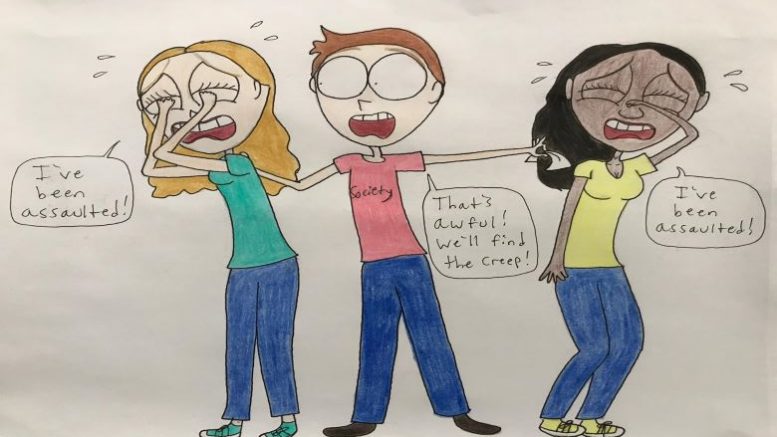Amanda George/Contributing Writer
The recent murder of Sarah Everard and the possible end of America’s crime decline has left many folks feeling that this year has become more tragic than thought possible. With the onset of the COVID-19 pandemic, many domestic violence advocates raised concerns over the quarantining of victims with their abusers, citing a WHO report finding that “worldwide, nearly 1 in 3, or 30%, of women have been subjected to physical and sexual violence by an intimate partner or non-partner sexual violence or both.”
For most people upon being asked to conjure up an image of a female victim they’ve seen recently covered by the media, it would most likely be a white, innocently portrayed young woman. Any of these would include Sarah Everard, Natalee Holloway, Jayme Kloss, Tristyn Bailey, Jill Dando and countless others in the titles of podcast episodes. This phenomenon is criminologically and socially referred to as Missing White Woman Syndrome, as there has been a recent realization of racial and class biases upon examining coverage of victims of violent crimes.
Of course, this isn’t to say that white female victims don’t deserve to be covered in the media, or even deserve what happens to them. There is a glaring bias in the coverage of violent crimes, focusing on “perfect” white victims: women who are seen to be more vulnerable – with a more routine, negative portrayal of “lesser” victims, women of color. It goes without saying that this trend is problematic and perpetuates harmful stereotypes. As psychologist Scott Bonn says, attractive, young, white, female victims have sociologically become the subjects that cause high viewership and concern. For the media, increased viewership leads to increased revenue, so the popularized coverage of these victims continues.
Now, this is where the issue comes in; if these crimes with white female victims and women of color occurred at similar rates, then this disproportionate coverage would be appalling but easily apparent. That isn’t true- it’s hard to determine the concrete difference between rates of violence women experience due to the lack of accurate reporting, but as of 2019, white females only accounted for 7.9% of missing people while women of color were 10.1%, supporting the basis for Missing White Woman Syndrome. Sometimes these cases do gain publicity due to the mysterious circumstances surrounding the case or poor police work, but the underlying cause for the popular coverage can ultimately be attributed to a victim’s attributes.
This distorted coverage has proven to be harmful in society and the criminal justice system as those who commit said crimes against white female victims have received the death penalty more often than offenders who have committed offenses against other races and male victims. As Sarah Everard’s accused murderer is a police officer himself, there is supported distrust of law enforcement, amplified in communities of color. There is also the exclusion of transgender women from female victim statistics, as they are often thought to be “other” or categorized on their own to formulate specific statistics.
Abigail Curlew, a journalist, doctoral researcher and transfeminist, states that “When a cis[gender] person often says ‘woman,’ they mean cis woman as a default…As opposed to cis and trans being descriptors for women, and, like women, cis women and trans women being equally in the category of women.” This cisgender definition of women within statistics, specifically crime and victim statistics, ignores crimes committed against transgender women, specifically the intersection of trans women of color. As a result, stigmas and distancing between transgender and cisgender women deepen and perpetuate hate crimes or plain old violence.
For example, fifteen percent of transgender individuals report being sexually assaulted in police custody or jail, while 32 percent of African-American transgender people have reported this. As of 2019, there were 175 victims of anti-transgender hate crimes, but this comes from about 2,172 law enforcement agency reports out of about 15,000 existing agencies. As the U.S. Republican Party fixates on creating a plethora of bills against transgender peoples, 127 to be exact, this year so far has had a doubling of transgender murders from 2020, Sosin reports. As the Human Rights Campaign reports, 14 transgender individuals have been murdered since the start of 2021, with eight of them being Black women. Women of color victims are underreported within media with transgender women being even more underreported; news media’s lack of reporting race-driven and other hate offenses essentially ignores said issues in favor of gaining sympathy for victims with “potential”, i.e. a white woman.
Sarah Everard’s death could serve as a wake-up call for most, though. At least, if we take it as the last straw for accepting a culture where 71% of UK women answered that they had experienced sexual harassment in public spaces and where women share their personal protective measures for walking or driving alone. As Forbes highlights, men are killed at a rate three to four times more than women, where the offenders are other men, begging the question, why do men feel any safer than women? If they don’t, it makes more sense that all of us should advocate for solutions, although these don’t come in the form of increased police presence.
It seems we’ve accepted that while men suffer higher homicide rates than women, women will always possess the role of the vulnerable victim as the media likes to portray and profit from. It also must be said that the majority of violent crimes are intraracial, meaning within races, making them less appetizing for news media to report on unless there is a sensational aspect (missing, a crime of passion, police error, etc.). Interracial crimes, especially where the perpetrator or suspect is of color are more often reported on, enough where the public will joke that a Black man killing a white woman “won’t even get a trial and go straight to the chair”.
This all being said, I don’t have a solution for this other than the obvious: change reporting. Statistics show that news reporting isn’t reflective of police statistics in the slightest, and there isn’t a need for inflection within news reports. Aside from unbiased, factual and not cherry-picked reporting, there should be more highlighting of systemic issues within reporting and society and their effects.
DISCLAIMER:
The opinions presented within this page do not represent the views of PantherNOW Editorial Board. These views are separate from editorials and reflect individual perspectives of contributing writers and/or members of the University community






Be the first to comment on "Missing Girls: A White Portrait"